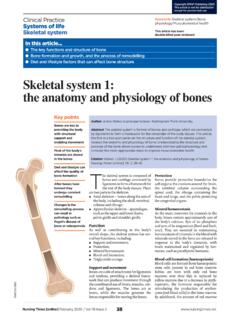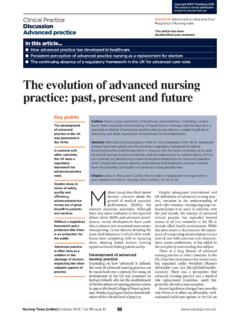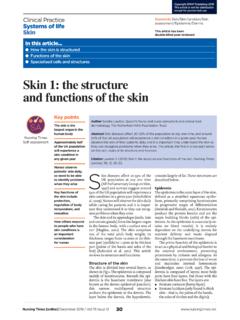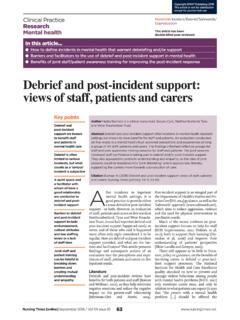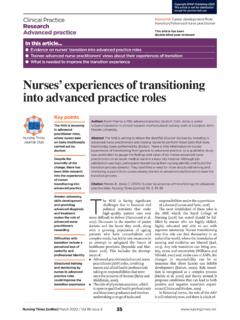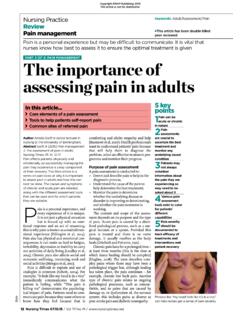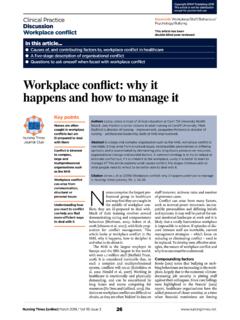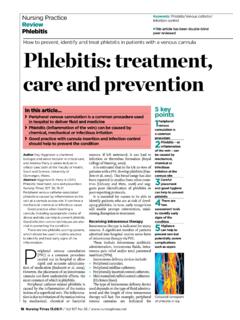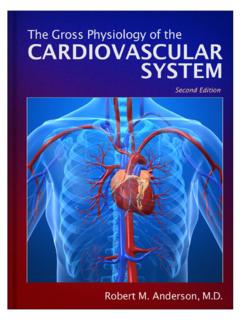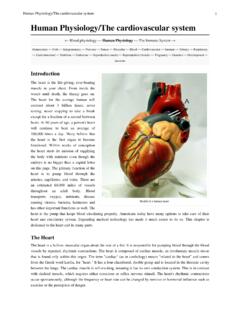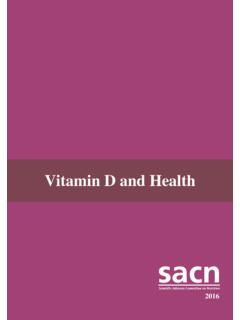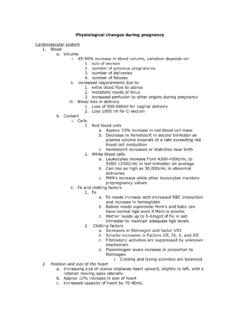Transcription of Homeostasis Part 1: anatomy and physiology
1 CLINICAL systems of lifeNT 4 April 2006 Vol 102 No 14 Brendan Doherty, msc, PGCe, RN, is nurse patient access manager, Prince of Wales Hospital, Sydney, Australia; Colette foudy, RN, GradDip, is clinical care coordinator, intensive care unit, St George Private Hospital, Sydney, Australia. This article, the first in a series of four, looks at the anatomy and physiology of Homeostasis . Homeostasis comprises the dynamic processes that enable optimum conditions to be maintained for cells, in spite of continual changes taking place internally and externally (Clancy and McVicar, 1995).
2 All the systems of the human body are involved, with particular contributions by the endocrine, nervous, respiratory and renal systems. Whenever an imbalance occurs, regulatory systems become active to restore optimum conditions, usually by a process known as negative feedback in which a deviation from the normal level is detected and initiates changes that bring the level back to where it should be (Clancy and McVicar, 1995). These systems have to endure for survival and adapt to modifications of the environment so must therefore evolve.
3 anatomy and physiologyMany factors affect the suitability of body fluids to sustain life. These will be explored later in this series. They include:l Oxygen (O2) and carbon dioxide (CO2) concentrations;l The pH of the internal environment;l Concentrations of nutrients and waste products; l Concentration of salt and other electrolytes (osmoregulation);l Volume and pressure of extracellular fluid;l Body temperature;l Blood glucose these properties affect the chemical reactions that sustain life, there are built-in physiological mechanisms to maintain them at desirable levels.
4 The body needs Homeostasis to maintain stability and survive by ensuring that the internal environment remains relatively constant (Tortora and Anagnostakos, 2003). To enable cells to survive, the composition of the intracellular and extracellular fluids must be accurately maintained at all times. Intracellular fluid accounts for two-thirds of total water content (Tortora and Anagnostakos, 2003). Extracellular fluid includes gases, nutrients, plasma (in blood vessels) and ions, all of which are necessary for maintaining life (Tortora and Anagnostakos, 2003) (Fig 1).
5 Extracellular fluid circulates constantly within Part 1: anatomy and physiologyBrainearspinal cordeyestaste and smell sensorsskin sensorsNervesPineal glandthyroidAndrenalsovariestestesHypoth alamusPituitaryPancreasfiG 1. extRACellulAR fluiD AND BlooD vessels ArteryArterioleCapillaryvenuleveinCapill aryPlasmaextracellularfluidNeRvous systemeNDoCRiNe systemfiG 2. tHe eNDoCRiNe AND CeNtRAl NeRvous systemsthymusCellJohnny ZygoThis article has been double-blind peer-reviewed. For related articles on this subject and links to relevant websites see NT 4 April 2006 Vol 102 No 14 keywoRDs n anatomy and physiology n Homeostatic control27the blood and lymphatic system and is known as the body s internal environment (Tortora and Anagnostakos, 2003).
6 The body is said to be in Homeostasis when its internal environment contains: l Optimum levels of gases, ions, water and nutrients;l Is at optimal temperature; l Has optimal pressure for the health of disturbance in these optimum conditions causes failure of the organs and may lead to death (Tortora and Anagnostakos, 2003).Homeostatic controlThe endocrine and central nervous systems are the major control systems for regulating Homeostasis (Tortora and Anagnostakos, 2003) (Fig 2). The endocrine system consists of a series of glands that secrete chemical regulators (hormones).
7 The nervous system can detect deviation from the body s normal equilibrium (state of Homeostasis ) and sends messages to the affected organ to counteract this disturbance. Over a relatively short time it restores the required balance. Both systems act mostly automatically but there is some voluntary control over the nervous system (Sherwood, 1997).The control and maintenance of blood sugar levels is an example of homeostatic regulation by the endocrine system . Blood sugar is maintained by two hormones secreted by the pancreas: insulin and glucagon.
8 Blood sugar rises after digestion of food. In response, pancreas cells are stimulated to secrete insulin, which enables sugar uptake by cells and the storage of sugar in the liver and muscles. In effect, insulin decreases blood sugar levels to normal (Tortora and Anagnostakos, 2003).The respiratory system provides an example of homeostatic regulation by the nervous system . In normal breathing there is a state of Homeostasis . During exercise the respiratory system must work faster to keep the O2 in the extracellular fluid and in the cells within normal limits, preventing excessive build-up of CO2 and disturbance to the blood pH through the accumulation of acid (Tortora and Anagnostakos, 2003).
9 Because muscles require more O2 during exercise, more CO2 is released and therefore also needs to be excreted (Tortora and Anagnostakos, 2003). These chemical changes are detected in certain nerve cells, which send this message to the cardio-respiratory centre in the medulla oblongata in the base of the brain (Docherty, 2002). The brain sends a message to the heart to increase its pumping action (heart rate) to take on more O2 and enable the blood to give up excess CO2. Respiratory muscles also receive instructions from the brain to contract faster, enabling a rise in both O2 delivery and CO2 feedbackHomeostasis is constantly disturbed by external factors, which can be described as a form of stress on the internal environment (Tortora and Anagnostakos, 2003).
10 These stresses can be:l Internal: occurring within the body, for example in pain, or as a result of high or low blood pressure;l External: occurring outside the body, for example as a result of heat, cold or loud noises. Since these stresses affect the chemical reactions sustaining life, there are built-in physiological mechanisms to maintain or return them to desirable levels. Each organ or structure has its own intrinsic way of keeping the internal environment within normal limits. When Homeostasis is altered there are two possible responses:l In negative feedback the system responds to reverse the direction of change.
